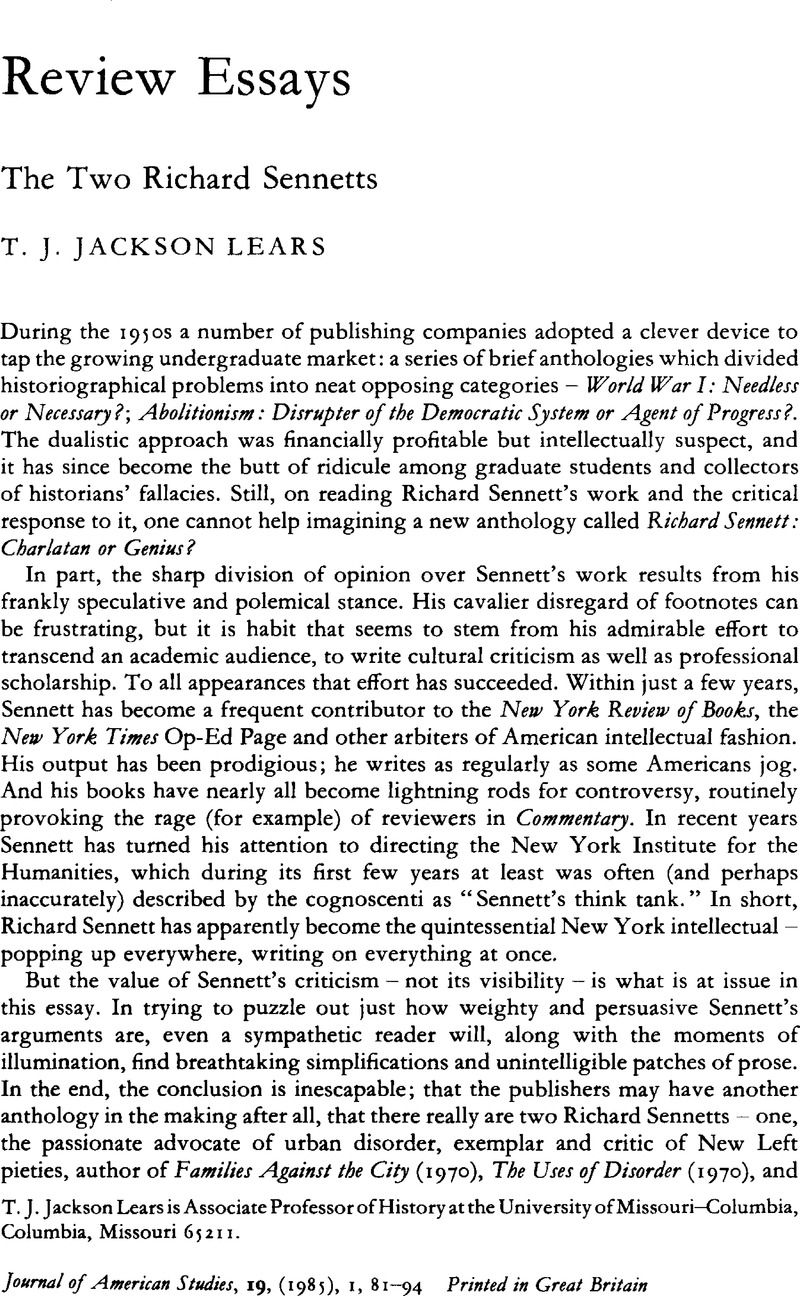No CrossRef data available.
Published online by Cambridge University Press: 16 January 2009

1 Sennett, Richard, Families Against the City (Cambridge, Mass.: Harvard University Press, 1970), p. 119CrossRefGoogle Scholar.
2 Ibid., p. 189.
3 Cott, Nancy F., The Bonds of Womanhood: Woman's “Sphere” in New England, 1780–1835 (New Haven: Yale University Press, 1977)Google Scholar; Smith-Rosenberg, Carroll, “The Female World of Love and Ritual,” Signs, 1 (1975), 1–24CrossRefGoogle Scholar; Mintz, Steven, A Prison of Expectations: The Family in Victorian Culture (New York: NYU Press, 1982)Google Scholar; Stowe, Steven, The Relations of Life: Family, Ritual, and Culture in the Antebellum Planter Class (Baltimore: Johns Hopkins Press, forthcoming)Google Scholar.
4 These points were cogently made by Duis, Perry, who reviewed Families in the American Journal of Sociology 76, (03 1971), 956CrossRefGoogle Scholar; and by Haller, Mark, “Family Fictions,” Reviews in American History 1 (03 1973), 113–19CrossRefGoogle Scholar. Sennett acknowledged his polemical intent in his “Comment” on an earlier version of this essay at the session “Sociological Perspectives on American Studies: the Work of Richard Sennett,” American Studies Association Annual Meeting, 1983. I am grateful for his receptiveness to criticsm.
5 Sennett, Families, p. 105.
6 Sennett, Richard, The Uses of Disorder: Personal Identity and City Life (New York: Knopf, 1970), esp. p. 157Google Scholar.
7 Ibid., pp. 82–83 ff.
8 Rieff, Philip, The Triumph of the Therapeutic: Uses of Faith After Freud (New York, Torchbook, Harper ed., 1966), p. 22Google Scholar.
9 Sennett, Richard, The Fall of Public Man (New York: Knopf, 1976), pp. 3–43Google Scholar, quotation p. 15.
10 Ibid., part two.
11 Ibid., esp. chap. 7, 8. Quotation, p. 39.
12 Ibid, quotation, p. 191.
13 Ibid., p. 255.
14 Stern, J. P., Hitler: the Führer and the People (London, 1975)Google Scholar, esp. chap. 2; Colhoun, Daniel, The Intelligence of a People (New York, 1974)Google Scholar; Lefebvre, Henri, Everyday Life in the Modern World, tr. Rabinowitch, Sacha (New York, Harpter Torch-books, 1971), p. 119Google Scholar; Baudrillard, Jean, Toward a Critique of the Political Economy of the Sign, tr. Levin, Charles (St Louis, Mo.: Telos Press, 1981), p. 65Google Scholar; Lowe, Donald, The History of Bourgeois Perception (Chicago: University of Chicago Press, 1982)Google Scholar.
15 Halttunen, Karen, Confidence Men and Painted Women: a Study of Middle Class Culture in America, 1830–1870 (New Haven: Yale University Press, 1982)Google Scholar.
16 Riesman, David et al. , The Lonely Crowd, 3rd revised edn (New Haven: Yale University Press, 1969), chap. 13Google Scholar.
17 Sennet, Richard and Cobb, Jonathan, The Hidden Injuries of Class (New York: Knopf, 1972), pp. 36, 58, 75Google Scholar.
18 Ibid., pp. 119–50.
19 Ibid., pp. 94 ff.
20 Ibid., pp. 96–97. I have discussed Gramsci's notion of divided consciousness – and its limitations – in “The Concept of Cultural Hegemony: Problems and Possibilities,” a paper presented at the O.A.H Annual Meeting, 1984.
21 Sennett, and Cobb, , Hidden Injuries, pp. 181–231Google Scholar.
22 Ibid., pp. 159 ff., 258.
23 Sennett, Richard, Authority (New York: Knopf 1980), pp. 26–41Google Scholar.
24 Ibid., pp. 56–83.
25 Ibid., chap. 3.
26 Ibid., p. 118.
27 Sennett's novels are The Frog Who Dared to Croak (New York: Farrar, Straus and Giroux, 1982)Google Scholar and An Evening of Brahms (New York: Knopf, 1984)Google Scholar. Haller, “Family Fictions” explicitly dismisses Families as fiction in the narrow sense. The phrase “regulative fictions” is Frank Kermode's; it is quoted without citation by Gordon S. Wood, “Star-Spangled History,” review of Middlekauff, Robert, The Glorious Cause: the American Revolution, 1763–1789, New York Review of Books 29 (12 08 1982), p. 9Google Scholar.